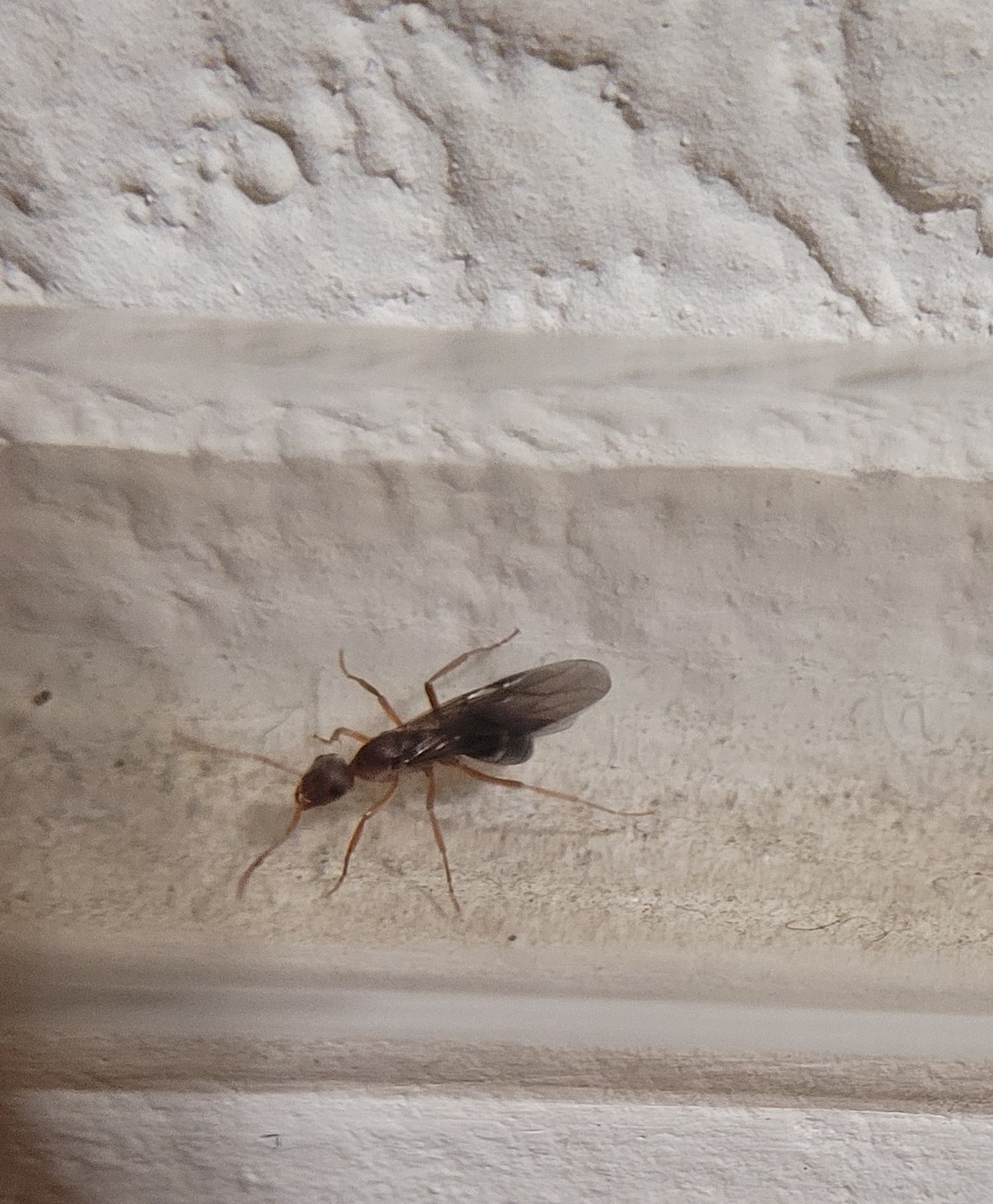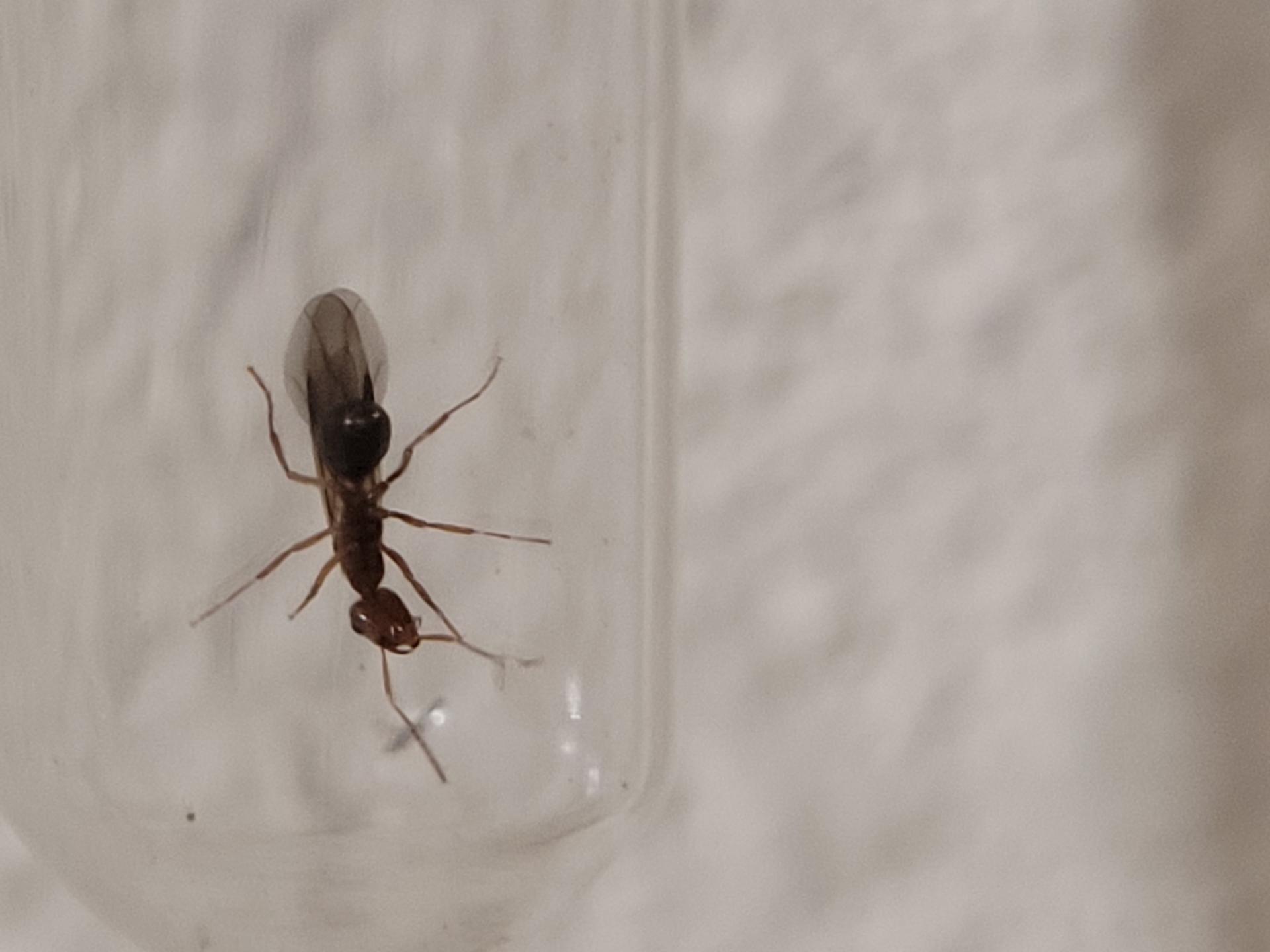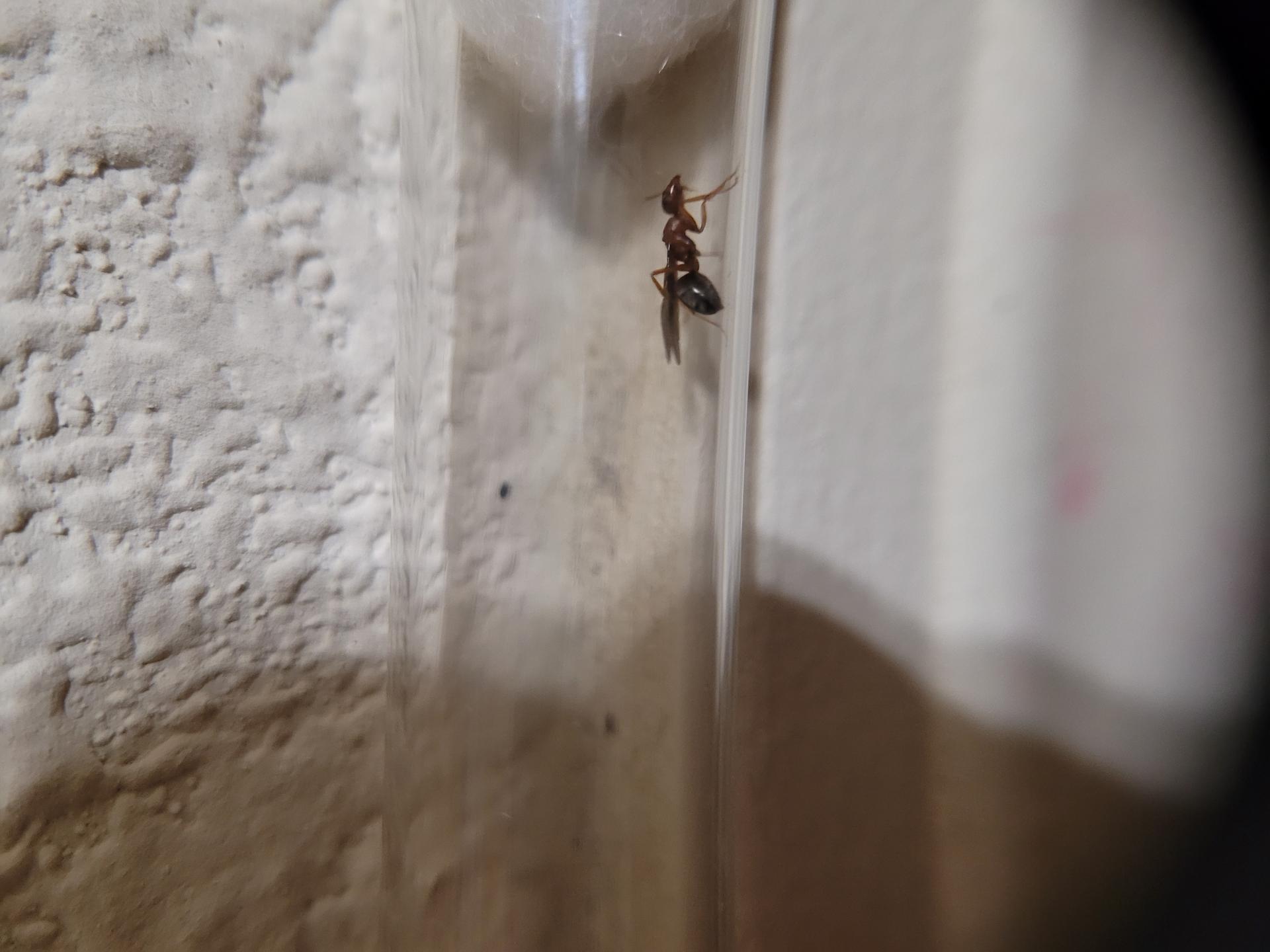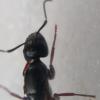- Formiculture.com
- Forums
- Gallery
- Members
- Member Map
- Chat
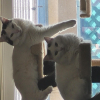
I need help identifying this queen
Started By
That_one_ant_guy
, May 22 2021 11:24 AM
23 replies to this topic
#1
 Offline
-
Posted May 22 2021 - 11:24 AM
Offline
-
Posted May 22 2021 - 11:24 AM
So I found this queen next to an argentine trail, and boy she was fast, when I finnaly got her into a test tube I tried to identify her but with no luck do you guys have an idea?
-That_one_ant_guy
-That_one_ant_guy
#2
 Offline
-
Posted May 22 2021 - 2:25 PM
Offline
-
Posted May 22 2021 - 2:25 PM
Interesting, she's an exceedingly slim Formica alate.
#3
 Offline
-
Posted May 22 2021 - 4:31 PM
Offline
-
Posted May 22 2021 - 4:31 PM
Yeah, that is not normal... If she gets workers I will be astonished. She likely has some genetic defect.
- TennesseeAnts likes this
Hi there! I went on a 6 month or so hiatus, in part due, and in part cause of the death of my colonies.
However, I went back to the Sierras, and restarted my collection, which is now as follows:
Aphaenogaster uinta, Camponotus vicinus, Camponotus modoc, Formica cf. aserva, Formica cf. micropthalma, Formica cf. manni, Formica subpolita, Formica cf. subaenescens, Lasius americanus, Manica invidia, Pogonomyrmex salinus, Pogonomyrmex sp. 1, Solenopsis validiuscula, & Solenopsis sp. 3 (new Sierra variant).
#4
 Offline
-
Posted May 22 2021 - 4:57 PM
Offline
-
Posted May 22 2021 - 4:57 PM
i wonder what the workers would look like
1X Pogonomyrmex occidentalis 40-50 Workers
1X Solenopsis molesta 10 Workers (mono)
Ants I Want: Crematogaster sp, Camponotus Sp., Ponera Pennsylvanica, Mymercocystus sp.
My Youtube channel: https://www.youtube....kUjx-dPFMyVqOLw
Join Our Fledgling Discord Server https://discord.com/...089056687423489
#5
 Offline
-
Posted May 22 2021 - 4:58 PM
Offline
-
Posted May 22 2021 - 4:58 PM
Could it be a formica microgyna group species? The microgyna group have tiny, leggy and slim queens. If so, she is parasitic and will need host workers.
My journals:
Polyergus Mexicanus: https://www.formicul...gs/#entry175528
Lasius minutus: https://www.formicul...cs/#entry174811
Lasius latipes: https://www.formicul...gs/#entry206449
General acanthomyops journal: https://www.formicul...yops-with-eggs/
Polyergus Mexicanus: https://www.formicul...gs/#entry175528
Lasius minutus: https://www.formicul...cs/#entry174811
Lasius latipes: https://www.formicul...gs/#entry206449
General acanthomyops journal: https://www.formicul...yops-with-eggs/
#6
 Offline
-
Posted May 22 2021 - 5:02 PM
Offline
-
Posted May 22 2021 - 5:02 PM
To my knowledge, none in CA look like this. I think this is a fusca group Formica, like francoeuri, that has genetic issues.
I guess it is possible though, if highly unlikely, so maybe boosting her with some workers could be a good idea.
Hi there! I went on a 6 month or so hiatus, in part due, and in part cause of the death of my colonies.
However, I went back to the Sierras, and restarted my collection, which is now as follows:
Aphaenogaster uinta, Camponotus vicinus, Camponotus modoc, Formica cf. aserva, Formica cf. micropthalma, Formica cf. manni, Formica subpolita, Formica cf. subaenescens, Lasius americanus, Manica invidia, Pogonomyrmex salinus, Pogonomyrmex sp. 1, Solenopsis validiuscula, & Solenopsis sp. 3 (new Sierra variant).
#7
 Offline
-
Posted May 22 2021 - 5:08 PM
Offline
-
Posted May 22 2021 - 5:08 PM
NickAnter, on 23 May 2021 - 01:02 AM, said:
this is a long shot, but it could possibly be undescribed. The microgyna group is the least understood of the parasitic formica groups.To my knowledge, none in CA look like this. I think this is a fusca group Formica, like francoeuri, that has genetic issues.
I guess it is possible though, if highly unlikely, so maybe boosting her with some workers could be a good idea.
My journals:
Polyergus Mexicanus: https://www.formicul...gs/#entry175528
Lasius minutus: https://www.formicul...cs/#entry174811
Lasius latipes: https://www.formicul...gs/#entry206449
General acanthomyops journal: https://www.formicul...yops-with-eggs/
Polyergus Mexicanus: https://www.formicul...gs/#entry175528
Lasius minutus: https://www.formicul...cs/#entry174811
Lasius latipes: https://www.formicul...gs/#entry206449
General acanthomyops journal: https://www.formicul...yops-with-eggs/
#8
 Online
-
Posted May 22 2021 - 5:30 PM
Online
-
Posted May 22 2021 - 5:30 PM
That’s the weirdest looking thing I’ve ever seen.
- TennesseeAnts and Antkeeper01 like this
"The ants are a people not strong, yet they prepare their meat in the summer." Prov. 30:25
Keep ordinary ants in extraordinary ways.
Keep ordinary ants in extraordinary ways.
#9
 Offline
-
Posted May 22 2021 - 5:35 PM
Offline
-
Posted May 22 2021 - 5:35 PM
Still even if it isn’t microgyna group, I would give her some formica pupae. Parasitic formica can usually open them by themselves, although callows is also recommended.
My journals:
Polyergus Mexicanus: https://www.formicul...gs/#entry175528
Lasius minutus: https://www.formicul...cs/#entry174811
Lasius latipes: https://www.formicul...gs/#entry206449
General acanthomyops journal: https://www.formicul...yops-with-eggs/
Polyergus Mexicanus: https://www.formicul...gs/#entry175528
Lasius minutus: https://www.formicul...cs/#entry174811
Lasius latipes: https://www.formicul...gs/#entry206449
General acanthomyops journal: https://www.formicul...yops-with-eggs/
#10
 Offline
-
Posted May 23 2021 - 7:44 AM
Offline
-
Posted May 23 2021 - 7:44 AM
Hmmmmm, yeah I might try giving her some formica pupae, her abdomen his pretty small compared to the rest of her body though, should I try giving her some sugar water?
#11
 Offline
-
Posted May 23 2021 - 8:09 AM
Offline
-
Posted May 23 2021 - 8:09 AM
So, this may be a longshot, but, maybe this is some sort of an intercaste ant.
#12
 Offline
-
Posted May 23 2021 - 8:11 AM
Offline
-
Posted May 23 2021 - 8:11 AM
That_one_ant_guy, on 23 May 2021 - 3:44 PM, said:
yes, most parasite queens are malnourished in the nest due to the amount of alates produced.Hmmmmm, yeah I might try giving her some formica pupae, her abdomen his pretty small compared to the rest of her body though, should I try giving her some sugar water?
My journals:
Polyergus Mexicanus: https://www.formicul...gs/#entry175528
Lasius minutus: https://www.formicul...cs/#entry174811
Lasius latipes: https://www.formicul...gs/#entry206449
General acanthomyops journal: https://www.formicul...yops-with-eggs/
Polyergus Mexicanus: https://www.formicul...gs/#entry175528
Lasius minutus: https://www.formicul...cs/#entry174811
Lasius latipes: https://www.formicul...gs/#entry206449
General acanthomyops journal: https://www.formicul...yops-with-eggs/
#13
 Offline
-
Posted May 23 2021 - 2:08 PM
Offline
-
Posted May 23 2021 - 2:08 PM
I found some formica workers but couldn't track down the nest☹ but, I gave her some sugar water and she seems to be enjoying it
Edited by That_one_ant_guy, May 23 2021 - 2:09 PM.
#15
 Offline
-
Posted May 24 2021 - 5:51 AM
Offline
-
Posted May 24 2021 - 5:51 AM
#16
 Offline
-
Posted May 24 2021 - 6:02 AM
Offline
-
Posted May 24 2021 - 6:02 AM
Genetic defect, huh? Interesting, exited to see what her workers might look like (if they don't look similar that would be somewhat disappointing). Is it possible if another queen has a similar genetic defect and the colonies alates and drones mix, will it result into a new species or a physical trait difference, like how species can have differentiating colours?
シグナチャーです。예.
#17
 Offline
-
Posted May 24 2021 - 6:19 AM
Offline
-
Posted May 24 2021 - 6:19 AM
I'm seeing a lot of Formica fusca-group species that look fairly similar to this. I'm not going to guess a species, as I'm not the best at Formica identification, but a species similar to F. subelongata seems to be a good match. Take this with a grain of salt though, 'cause I'm no Formica expert.
- TennesseeAnts likes this
Currently Keeping:
Camponotus chromaiodes, Camponotus nearcticus, Stigmatomma pallipes, Strumigenys brevisetosa, Strumigenys clypeata, Strumigenys louisianae, Strumigenys membranifera, Strumigenys reflexa, Strumigenys rostrata
#18
 Offline
-
Posted May 24 2021 - 7:50 AM
Offline
-
Posted May 24 2021 - 7:50 AM
Chickalo, on 24 May 2021 - 2:02 PM, said:
Genetic defect, huh? Interesting, exited to see what her workers might look like (if they don't look similar that would be somewhat disappointing). Is it possible if another queen has a similar genetic defect and the colonies alates and drones mix, will it result into a new species or a physical trait difference, like how species can have differentiating colours?
Most likely the latter for a very, very long time, assuming these can survive and found colonies, but it would definetly not be a new species as this colonies alates could probably still mate with other colonies alates of this species and such a pairing would produce viable and fertile alates. It maybe could develop into a new species, but it would not be within any of our lifetimes, unless someone finds a way to live thousands or millions of years.
- Chickalo likes this
#19
 Offline
-
Posted May 28 2021 - 5:20 PM
Offline
-
Posted May 28 2021 - 5:20 PM
Do you know if she is capable of flying? That’d surprise me as much as her being able to have workers, if not more.
#20
 Offline
-
Posted May 29 2021 - 6:48 AM
Offline
-
Posted May 29 2021 - 6:48 AM
0 user(s) are reading this topic
0 members, 0 guests, 0 anonymous users



